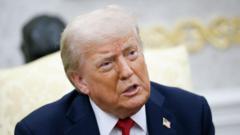The recent decision to implement a 17% tariff on Mexican tomatoes marks a significant shift in US trade policy, drawing mixed reactions and concerns over economic implications.
Trump's 17% Tariff on Mexican Tomatoes: Impact and Reactions

Trump's 17% Tariff on Mexican Tomatoes: Impact and Reactions
The US government imposes a new tariff on Mexican tomatoes amid rising tensions between the two nations.
The US has initiated a 17% tariff on a substantial portion of tomatoes imported from Mexico, effective immediately. This major policy change comes after the US terminated a longstanding agreement with Mexico, citing inadequate protection for American tomato growers from low-priced imports. According to US Secretary of Commerce Howard Lutnick, this move aims to rectify what he describes as unfair pricing practices that have negatively impacted local farmers who rely on tomato sales.
In response, the Mexican government strongly contested the accusation that it has been dumping tomatoes at reduced prices in the US market, asserting that the popularity of its tomatoes stems from their superior quality. Approximately 70% of tomatoes consumed in the United States are sourced from Mexico, according to industry statistics from the Florida Tomato Exchange. The direct consequence of the tariff is anticipated to push up prices for consumers at grocery stores and restaurants, affecting staples like pizza sauce and salsa.
Supporters of the tariff believe it will steer consumers towards domestically grown tomatoes, potentially revitalizing American agricultural markets. Conversely, Mexican authorities argue that the sheer volume of imports makes it impossible for the US to replace its tomato supply. They express intentions to negotiate a new trade deal to mitigate the impacts on their farmers, while also facilitating access to alternative markets for Mexican producers.
This issue is not new; US tomato farmers have sought government intervention since 1996, claiming unfair competition from their Mexican counterparts. Over the years, several agreements have been made to suspend tariffs in exchange for Mexico committing to price regulations. The latest agreement, established in 2019, was the basis for the recent tariff withdrawal.
Additionally, President Trump has hinted at further increasing tariffs, with a potential 30% duty on all goods imported from Mexico, scheduled to be enforced in August. This was justified by claims that Mexico has not adequately addressed issues related to drug trafficking. The broader implications of these tariffs extend beyond Mexico, with various countries including China, Brazil, and EU nations also facing potential levies.
The US economy's response to these tariffs, along with their overall effectiveness, continues to evolve as public discourse surrounding trade practices and their ramifications intensifies.




















